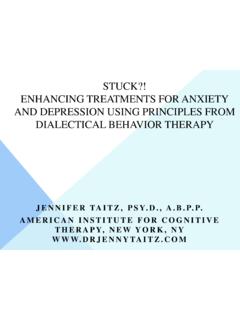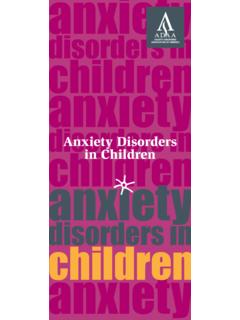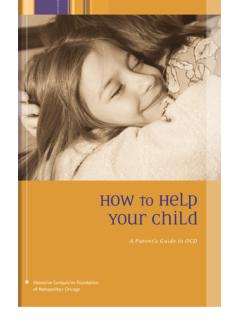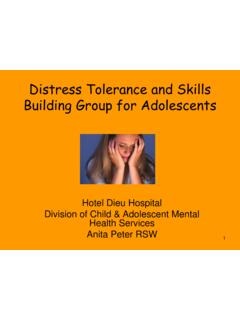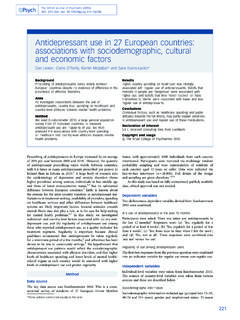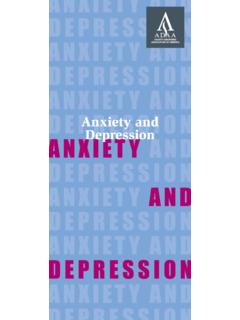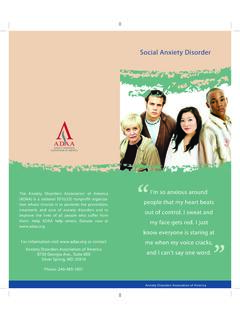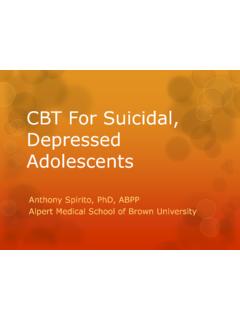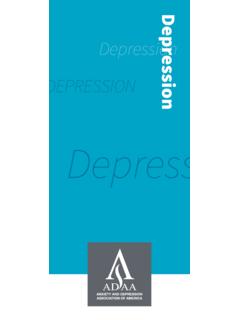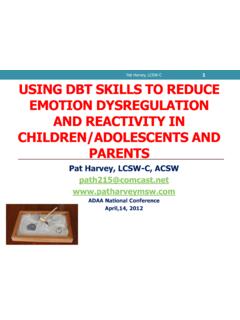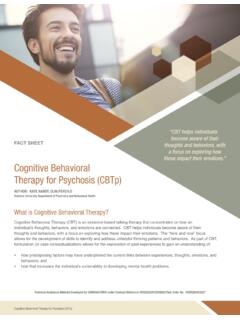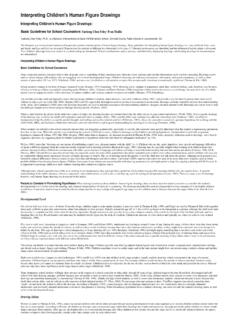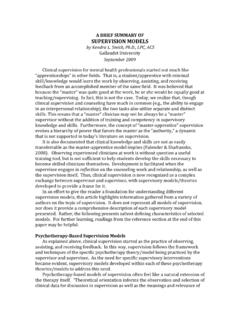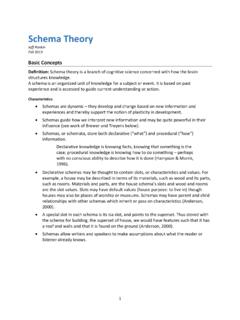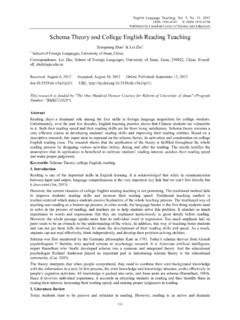Transcription of The History of Group Therapy
1 USING THE Group IN COGNITIVE Group Therapy Robert Schachter, Mount Sinai School of Medicine The History of Group Therapy Originally found successful in treating patients with TB in early 1900 s Later used during WW II for treating those with emotional reactions In the 1950 s Bion s work with the Group at Tavistock Clinic in London Lewin Systems Theory the Group whole is greater than the sum of its parts Yalom identified 11 characteristics that make Group Therapy effective Universality ( I m not alone nor have unique problems )
2 Group Cohesiveness Altruism (unselfish giving Instillation of Hope Imparting Information (educational),), Interpersonal Learning Development of Socializing Techniques Imitative Behavior Corrective Recapitulation of the Primary Family Group Catharsis Existential Factors Although various approaches to Group Therapy have different goals, the Group as an entity is central to all of them By nature of the Group interaction, the Group itself takes on an identity that is a function of, yet different from its members. This entity becomes an active participant in the treatment process Cognitive Therapy is extremely effective Cognitive Therapy teaches you how to identify the thoughts that underlie your feeling It then provides a simple way to determine if those thoughts are realistic If a thought is not realistic.
3 You can then replace it with a more realistic one based on what you know from hard data Cognitive Therapy is defined in terms of the cognitive model The model stipulates that psychological disorders are characterized by dysfunctional thinking derived from dysfunctional beliefs These beliefs are formed from early childhood experiences Changing your cognitions, the way you look at something, changes how you feel The therapist is interactive and serves as a coach who teaches the skill set of identifying thoughts underneath feelings Once identified thoughts are tested for veracitude Socratic dialogue, collaborative empiricism, and guided discovery are used to help the patient see things differently FORMATION OF THE Group Evaluation Prior to Group guided interview to determine Axis I and Axis II diagnoses Treatment plan- long term.
4 Short term Similar life stage issues Similar diagnoses Minimum level of functioning Interactive Cognitive Group Therapy The first 6 sessions Cognitive Therapy skills are taught Psychoeducation re: disorder Describing connection between thought and feelings Use of the thought record Monitoring symptoms- anxiety, stress, irritability Sharing experiences The Group is taught the skills to serve the role of the a Cognitive Therapist The therapist guides the members to set up experiments to challenge beliefs that are not accurate By this point the Group has coalesced into a working body Phases of a Group Trust Phase- Therapist creates a safe background environment where rules are defined to protect confidentiality.
5 Where people are protected and not forced to expose emotions, where abusive behavior is prohibited Differentiation Phase- After trust is developed, this phase allows for members to start being themselves and relative positioning occurs Working Phase- This is the part of the Group where people start using the skills they have learned to identify and challenge thoughts and work on changing core beliefs Termination phase-When the Group is ready to end, loose ends get tied up and people sum up their experiences and say good-bye. Role of the Therapist Therapist is a teacher, a guide.
6 And a shepherd and plays an active role Forms the Group so members are compatible Develops Axis I and Axis II diagnoses for each patient Has long term and short term treatment plans for each patient Creates a safe emotional environment Teaches Cognitive Therapy skills in a way that they are understood Provides forms and charts to enable practicing what is learned Redirects material so that the Group takes on the role of therapist to understand and challenge thinking that is not realistic At Another Level Is Constantly Monitoring What Is Happening With Each Member When a member interacts the therapist is keeping in mind Axis I and Axis II diagnoses as well as what the patient is working on that session to achieve the goals Therapist redirects Group to functionally work on the skill that patient needs FORMS Group RULES Group POLICY 1.
7 Please keep all information that has been discussed in the Group confidential. 2. Personal contact outside the Group is not discouraged, but there can be no sexual contact between members. 3. Weekly attendance is very important. If unable to attend a session, please give advance notice. 4. If a member does not want to speak about a specific subject, that wish must be respected. 5. Space is reserved in the Group whether or not session is attended and is billed accordingly. 6. Payment is due on the last session of the month.
8 A late charge of 2% is assessed for payments received after the 10th of the following month. 7. For insurance reimbursement, forms will be provided immediately after receipt of payment. AUTOMATIC THOUGHT DYSFUNCTIONAL THOUGHT RATIONAL THOUGHT 1979., AT Beck ELEVEN FORMS OF DYSFUNCTIONAL THOUGHT 1. All-or-nothing You see things in black-or-white categories. If a situation falls short thinking of perfect you see it as a total failure. 2. Overgeneralization You see a single negative event, such as a romantic rejection or a career reversal, as a never-ending pattern of defeat by using words such as "always" or "never" when you think about it.
9 3. Mental Lens or Filter You pick out a single negative detail and dwell on it exclusively, so that your vision of all of reality becomes darkened, like the drop of ink that discolors a beaker of water. 4. Discounting the You reject positive experiences by insisting they "don't count." Positive 5. Jumping to You interpret things negatively when there is not sufficient evidence to support your conclusions. Conclusions 6. Magnification You exaggerate the importance of your problems and shortcomings, or you minimize the importance of your desirable qualities.
10 7. Emotional You assume that your negative emotion necessarily reflect the way things really are. Reasoning 8. Should Statements You tell yourself that things should be the way you hoped or expected them to be. 9. Labeling Labeling is an extreme form of all-or-nothing thinking. You attach a negative label to yourself. 10. Personalization Personalization occurs when you hold yourself personally responsible for an event that isn't entirely under your control.
